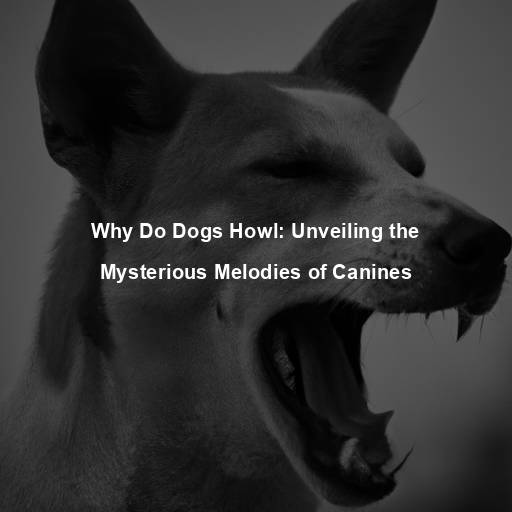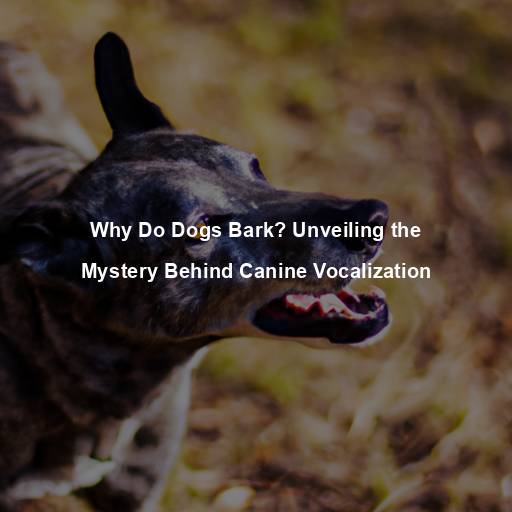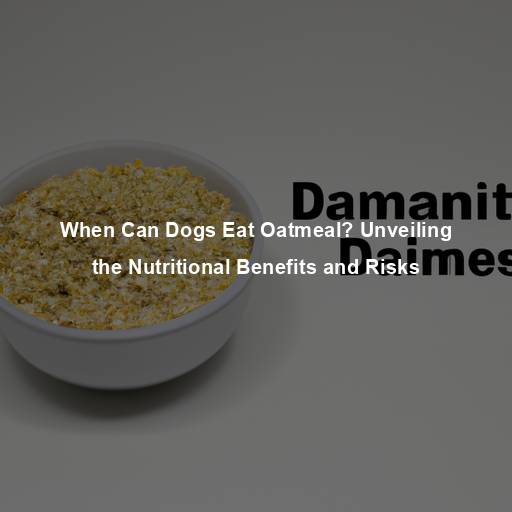Why Do Dogs Howl: Unveiling the Mysterious Melodies of Canines
Last Updated on August 4, 2023 by Evan
Contents [hide]
- 1 The Intriguing Language of Howls
- 1.1 The Call of the Wild: An Ancestral Echo
- 1.2 Expressing Emotional Distress: A Cry for Help
- 1.3 The Sound of Celebration: Canine Socializing
- 1.4 Unleashing Their Inner Opera Singer: Vocalization Practice
- 1.5 A Melodic Serenade: Territory Marking
- 1.6 Harmonizing with the Siren’s Song: Response to External Stimuli
- 1.7 The Chorus of Canine Communication: Joining the Pack
- 1.8 The Mystic Connection: Ancestral Bonds
- 2 A Harmonious Symphony of Canine Expression
- 3 The Multifaceted Nature of Howling
- 4 How to Respond to Your Dog’s Howling
- 5 The Melodies of Canine Connection
- 6 FAQs: Why Dogs Howl
- 6.1 Why do dogs howl?
- 6.2 Are certain dog breeds more prone to howling?
- 6.3 Can health issues cause excessive howling in dogs?
- 6.4 How can I prevent my dog from howling excessively?
- 6.5 Is it possible to train a dog to stop howling?
- 6.6 Should I be concerned if my dog suddenly starts howling excessively?
The Intriguing Language of Howls
Dogs are fascinating creatures that have been our loyal companions for thousands of years. Their ability to communicate with us and each other is a captivating aspect of their behavior. One of the most intriguing forms of communication exhibited by dogs is howling. But why do dogs howl?
The Call of the Wild: An Ancestral Echo
Did you know that dogs and wolves have a shared ancestry? It’s fascinating to consider that howling, which is deeply ingrained in their nature, could be a trait passed down from their wild ancestors. For wolves, howling serves as a form of communication within their pack, allowing them to establish their presence and strengthen social connections. Similarly, our furry companions, dogs, may howl to express their bonds with their human family or even fellow four-legged friends in their surroundings.
Expressing Emotional Distress: A Cry for Help
Similar to humans, our beloved canine friends also go through a roller coaster of emotions. Loneliness, anxiety, and fear are just a few of the complex feelings they may experience. When feeling distressed or isolated, dogs often resort to howling as a way to reach out for assistance. This behavior tends to become more apparent when they are left alone for extended periods or suffer from separation anxiety.
The Sound of Celebration: Canine Socializing
Unraveling the enigmatic symphony of canine communication, one can witness an intriguing paradox: the resonant howls that echo through the air may not always signify anguish or tribulation. These melodious outbursts, when entangled in moments of exultation and bliss, paint a vivid portrait of jubilation and camaraderie. As a dog reunites with its beloved human companion or crosses paths with a four-legged compatriot, their vocal harmonies transcend the realm of distress signals and metamorphose into joyous celebrations, like a cryptic nod to the cosmos, whispering, “Behold, I am elated in your presence”! or “Let our blissful escapades commence”!
Unleashing Their Inner Opera Singer: Vocalization Practice
When it comes to our furry companions, howling is more than just a noise – it’s a symphony of communication. Much like humans honing their musical talents, dogs use howling as a means to fine-tune their vocal abilities. Puppies, in their quest to master the art of expression, actively engage in a delightful chorus of experimentation – testing and refining their howls. Through this delightful trial and error, they gradually become maestros of conveying various messages through their melodic howls.
A Melodic Serenade: Territory Marking
In the wild, wolves howl to mark their territory and communicate their presence to other packs. Similarly, dogs may howl to assert their ownership over a particular space or to ward off potential intruders. This territorial howling serves as a vocal boundary and a warning sign to other animals that they are encroaching on the dog’s perceived domain.
Harmonizing with the Siren’s Song: Response to External Stimuli
Dogs possess an incredible ability to perceive and react to the world around them. With acute sensitivity, they can be easily captivated by a multitude of external triggers. The resonating wail of sirens, the melodic hum of musical instruments, or even particularly piercing tones can suddenly awaken their primal instincts, prompting an enigmatic howl to escape their throats. This intriguing behavior serves as their unique way of participating in and acknowledging unfamiliar auditory landscapes that surround them.
The Chorus of Canine Communication: Joining the Pack
When one dog starts howling, it can trigger a domino effect within a group. Dogs are social animals, and their instinct to join in a howling chorus can be a form of communal communication. This behavior is more commonly observed in dogs that live in close proximity to each other, such as those in a household or a shelter.
The Mystic Connection: Ancestral Bonds
The phenomenon of dogs howling in response to certain sounds, such as music or sirens, may also be attributed to their ancestral connection with wolves. Music, with its rhythmic patterns and melodies, can resonate with a dog’s primal instincts, evoking a response that harkens back to their wild heritage. It’s as if they are transported to a time when their ancestors roamed the untamed lands, singing their songs under the moonlit sky.
A Harmonious Symphony of Canine Expression
Through a myriad of inexplicable factors, the enigmatic melodies of a dog’s howl draw us into a perplexing realm of communication. The ethereal tones echo their mere existence, unraveling a complex tapestry of emotions and desires. With each piercing howl, dogs seek companionship, assert their territorial claims, and respond to the enigmatic stimuli that surrounds them. These harmonies, devoid of linguistic constraints, resonate at a primal level, reminding us of the profound connection we share with these beguiling creatures and the sheer wonder they infuse into our lives.
Get ready to immerse yourself in the mysterious world of howling as we delve into the enigmatic origins behind this intriguing behavior. From ancient legends to scientific theories, join us on a thrilling journey of discovery as we unravel the secrets of this captivating vocalization. With expert insights and fascinating anecdotes, prepare to be perplexed and enlightened by the fascinating history and significance of howling in the animal kingdom. Watch this space for an exclusive exploration into the mesmerizing world of howling, coming soon on PetsRoof.com.
A Remnant of the Wild: Tracing Back to Wolves
Have you ever wondered why our furry friends unleash the haunting melody of their howls? Brace yourself as we embark on a journey into the depths of their ancestral heritage. Descendants of the mighty wolves, dogs carry within them a tapestry of instinctual behaviors passed down through generations. One such behavior is the enigmatic act of howling.
Unveiling Canine Emotions: The Language of Howls
Dogs, with their undeniable charm and unwavering loyalty, possess a fascinating ability to communicate without uttering a single word. Their nonverbal language, shrouded in mystery and complexity, incorporates a curious phenomenon: howling. This hauntingly beautiful sound serves as a powerful signal, allowing these furry friends to express their deepest emotions and desires. Whether driven by aching solitude, restless anxiety, or trembling fear, when dogs release their melodic cries into the wind, they are earnestly reaching out to both their human caretakers and their four-legged counterparts, in search of solace and understanding.
The Influence of Sound: External Triggers for Howling
Dogs, those marvelous creatures, boast an extraordinary gift: their superhuman auditory prowess that eclipses our own. This remarkable ability to pick up on even the faintest of sounds leaves them vulnerable to the whims and wonders of their sonic surroundings. Whether it be the deafening wail of sirens, the melodic strum of musical instruments, or the piercing shrill of high-pitched notes, these auditory stimuli have an uncanny power over our four-legged friends, transforming them into harmonizing maestros. It’s almost as if they are bewitched, inexplicably called to join in on this enchanting symphony that carries with it a mysterious resonance, stirring something deep within their canine essence.
Vocal Practice: Polishing the Howling Skills
Just like humans trying to find their voice, dogs also indulge in the art of howling. It’s especially prevalent among young pups, who are still honing their communication skills. These furry little learners experiment with their howls, mastering the art of conveying various messages. So, the next time you encounter a symphony of playful puppy howls, embrace the beautiful chaos as they navigate the perplexing world of vocalization.
The Multifaceted Nature of Howling
The Echoes of Loneliness: Separation Anxiety
Isn’t it fascinating how dogs, those affectionate social creatures, can feel such profound attachment to their human counterparts? It’s truly heartwarming, but also quite perplexing, how their emotions can turn into separation anxiety when left alone for too long. In their desperate attempt to fill the void and find solace, they resort to howling – a haunting yet strangely beautiful sound that echoes through the empty spaces. As responsible pet owners, it is our duty to offer them the support they need, and seek professional advice if necessary, because our furry friends deserve nothing less than our unwavering love and understanding.
Establishing Territory: The Vocal Markers
In the animal kingdom, territory is a highly valued resource. Dogs, being descendants of wolves, have preserved this instinct for territoriality. Howling serves as a vocal boundary, indicating to other animals that a particular space belongs to a certain dog or pack. By asserting their ownership through howling, dogs deter potential intruders and maintain a sense of security within their perceived domain.
The Language of Celebration: Expressing Joy
Howling is not always a sign of distress; it can also be an expression of pure happiness and excitement. Dogs may howl when they are reunited with their favorite humans or fellow furry friends. It’s their way of saying, “I missed you”! or “Let’s have an adventure together”!
The Power of the Pack: Communal Howling
There is something truly captivating about the inherent nature of dogs as social creatures. Deeply ingrained within their pack mentality is a profound inclination to seek companionship and belonging. This becomes evident in the peculiar phenomenon of howling, where the sound of one dog’s melancholic melody has the power to ignite a symphony of voices, as if a chain reaction were set in motion. This communal act holds more significance than meets the eye; it is an enchanting display of bonding and communication within the pack.
How to Respond to Your Dog’s Howling
Understanding Your Dog’s Needs: Emotional Support
When your beloved pooch unleashes their melodic howl, it’s crucial to delve beneath the surface and decipher the enigmatic emotions that lie within. Our loyal canine companions often howl to express their distress or anxiety, yearning for solace and understanding. By showering them with emotional support and tranquility, we can embark on a transformative journey. Engage in heartwarming activities, bask in their joyful presence, and seek expert advice if the somber tunes persist.
Minimizing Triggers: Managing External Stimuli
When it comes to our beloved canine companions and their curious habit of howling, it’s natural to feel a sense of perplexity. However, fear not, dear reader, for there are steps we can take to navigate this melodic mystery. One strategy to consider is minimizing your dog’s exposure to the triggering sounds that incite their vocal expression. If sirens have them howling like a wolf in the night, try closing windows or employing the use of white noise machines to muffle the intensity.
Seeking Professional Assistance: Behavior Modification
Is your furry friend’s howling reaching peak levels of annoyance and causing chaos in your household? Fear not, for salvation lies in the form of a seasoned dog behaviorist or trainer. These experts possess the uncanny ability to delve deep into the mysterious reasons behind your dog’s vocal outbursts and concoct a tailor-made plan to tackle the issue head-on. Brace yourself for a transformative journey as you embark on the path to curbing, redirecting, and ultimately conquering your four-legged companion’s howling escapades.
The Melodies of Canine Connection
A Window into Canine Expression: A Unique Language
The haunting sound of a dog’s howl echoes through the ages, a symphony of raw emotion that transcends language barriers. It is an ancient call that reaches deep into the core of our souls, drawing us closer to our furry companions and reminding us of their wild lineage. Embrace this enigmatic melody as a testament to the mystical connection forged between humans and canines, and let it stir within you a sense of awe and wonder.
So, the next time your ears are graced with the ethereal sound of a dog’s howl, take a moment to appreciate the multifaceted nature of this vocalization. It’s a reminder of the rich tapestry of emotions, instincts, and connections that make our relationship with dogs so extraordinary. Join us in celebrating the mysterious melodies of canines and continue exploring the fascinating world of pets on PetsRoof.com, where every wag, purr, and chirp finds a special place in our pet-loving hearts.
FAQs: Why Dogs Howl
Why do dogs howl?
Dogs howl for various reasons, and it is their way of communicating. One common reason dogs howl is to express their emotions or seek attention. They may howl when they are feeling lonely, anxious, or bored. Howling also serves as a way for dogs to communicate with other dogs, particularly over long distances. In some cases, dogs may howl in response to certain sounds or as part of their natural instincts.
Are certain dog breeds more prone to howling?
Yes, some dog breeds are generally more prone to howling than others. Certain breeds, such as Siberian Huskies, Alaskan Malamutes, and Beagles, have a strong instinct to howl due to their ancestral background or specific breed traits. These dogs were historically bred for activities like hunting or sledding, where howling was essential for communication over long distances. However, it is important to note that individual dogs within any breed can vary in their tendency to howl.
Can health issues cause excessive howling in dogs?
When our furry friends just can’t seem to stop howling, it’s important to consider the possibility of health issues. Those precious pups may be experiencing pain, discomfort, or perhaps even specific medical conditions that cause them to unleash their vocal prowess. To ensure the well-being of our beloved canine companions, it is wise to seek guidance from a qualified veterinarian who can help unravel the mysteries behind their symphony of howls.
How can I prevent my dog from howling excessively?
If you’ve ever been kept up at night by your furry friend’s out-of-tune serenades, you’re not alone in feeling like a perplexed pet owner. Tackling the puzzle of excessive howling requires a deep dive into the complex reasons behind this perplexing behavior. To crack the code, experts suggest a multi-faceted approach that involves engaging Fido in a burst of physical activities, mind-bending mental exercises, and paw-some social interactions to keep those loneliness-induced howls at bay. Combine this with establishing a mysterious consistency to your dog’s routine, fulfilling their basic needs, and introducing mind-boggling distractions or toys, and you might just find yourself in the midst of blissful silence. Lastly, don’t forget to train your fur-ball to respond to secret commands like an undercover agent using a “quiet” cue, and watch as the howling mysteriously fades away.
Is it possible to train a dog to stop howling?
Are the endless howling sessions of your furry friend driving you insane? Fear not, for there is hope! Through the power of training and positive reinforcement, you can teach your beloved canine companion to quiet down on command or at least reduce the frequency and intensity of their vocal outbursts. Consistency, patience, and a dash of delectable rewards are key ingredients in this perplexing quest. However, it’s essential to keep in mind that completely eradicating a dog’s innate howling instincts may be an elusive feat. Yet, fret not, as with diligent training, you can achieve a harmonious balance between your pup’s nature and your sanity.
Should I be concerned if my dog suddenly starts howling excessively?
When your furry companion unexpectedly transforms into a vocal virtuoso, belting out howls left and right, it’s a head-scratching moment that calls for some detective work. Take a step back and ponder over any recent shifts in your dog’s demeanor, physical well-being, or surroundings. The sudden surge in howling might hint at hidden troubles lurking beneath the surface, like discomfort, restlessness, or overwhelming worry. Seeking guidance from a trusted vet could shed light on possible medical or emotional conundrums that may be fueling this peculiar symphony.





